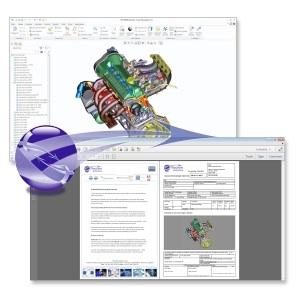Publish CAD Designs in PDF Format
July 16, 2014

Theorem Solutions recently announced the release of its newest software solution: Publish 3D. The program enables direct translation between CAD software and the PDF format, allowing engineers to spend more of their time doing what they do best -- creating.
Before Publish 3D, there was never an easy way to publish a 3D CAD design in a PDF format. Sure, engineering and design firms all have access to CAD software and understand geometry like they understand the laws of gravity, but often mass manufacturers (who foot the bill) don't.
This produces a big problem. If clients want to see mock-ups of their projects, they would either have to buy a design program (and at least learn the basics) or the designer would have to spend hours trying to find a universal program capable of showing the client the progress made so far, anticipated end product, dimensions, potential building material, etc. But Publish 3D may change all of that.

With Publish 3D, designers who use PTC's Creo can now create PDF files on demand. If a client asks for a mock-up, the innovator need only open the design in Creo and click "save as PDF." Clients can now easily (and professionally) view the project for which they are dishing out their dough.
Publish 3D allows designers to publish the full design of a 3D structure in a compressed PDF format. Innovators can send their clients the full 3D model, and they can also send them specific sub-assemblies and model trees. For example, if you are designing a home for a client, you can send him or her the full 3D mock-up of the conceptualization. You can also send a model of the frame and foundation of the home. That's not all.
Innovators also have control over what views they send to clients. Let's say, for example, you have a client who wants you to design an acoustic music hall without any obvious support pillars inside of the main hall. If you've got an idea of how this might look, but you don't yet know the specific dimensions, when your client asks to see what you've been working on, you can "turn on" the final conceptualizations, but "turn off" the dimensions, materials, etc. until you know the specifics. Good ol' technology.
The technology for Publish 3D is largely based upon Theorem's Process Manager Suite. The Suite features a variety of data exchange automation tools, such as publishing a design on a schedule and sending that out to a designated email list. Publish 3D can do that, too.
Designers can establish an automated data sharing schedule with clients using Publish 3D and can customize what is sent to whom via email, ftp, or cloud-based platform. Also, since the designs are sent in PDF format, this opens the door to a new market base. Theorum estimates that there are many supply chains and other prospective clients who may need a designer, but lack CAD software and knowledge. Publish 3D bridges that gap.
Theorem also embedded Publish 3D with a number of tools that make designing and marketing easier. The program comes preloaded with marketing tools and resources that automatically calculate cost versus quality. Publish 3D will give innovators the cost of producing a particular design, and the expected quality based on different building materials. This not only helps the client analyze cost, but also reduces the risk of error. You don't want to build that acoustic music hall out of plaster -- no sir.
Once clients receive their PDF files, they have the power to annotate them. They can also share the files and expel them into other documents they can use in-house, such as PowerPoint, AVI movies, and Web-friendly formats.
Publish 3D also directly pulls data from MRP systems and other platforms across the engineering industry to generate forms and other data sets. In a nutshell, it's a one-stop-shop from confident, productive engineer to happy client.
The idea behind Publish 3D is to give designers and clients a more streamlined way of working together. When both parties are on the same page, it leads to a better working relationship, more referrals and more revenue. About time, right?
Related posts:
About the Author(s)
You May Also Like





